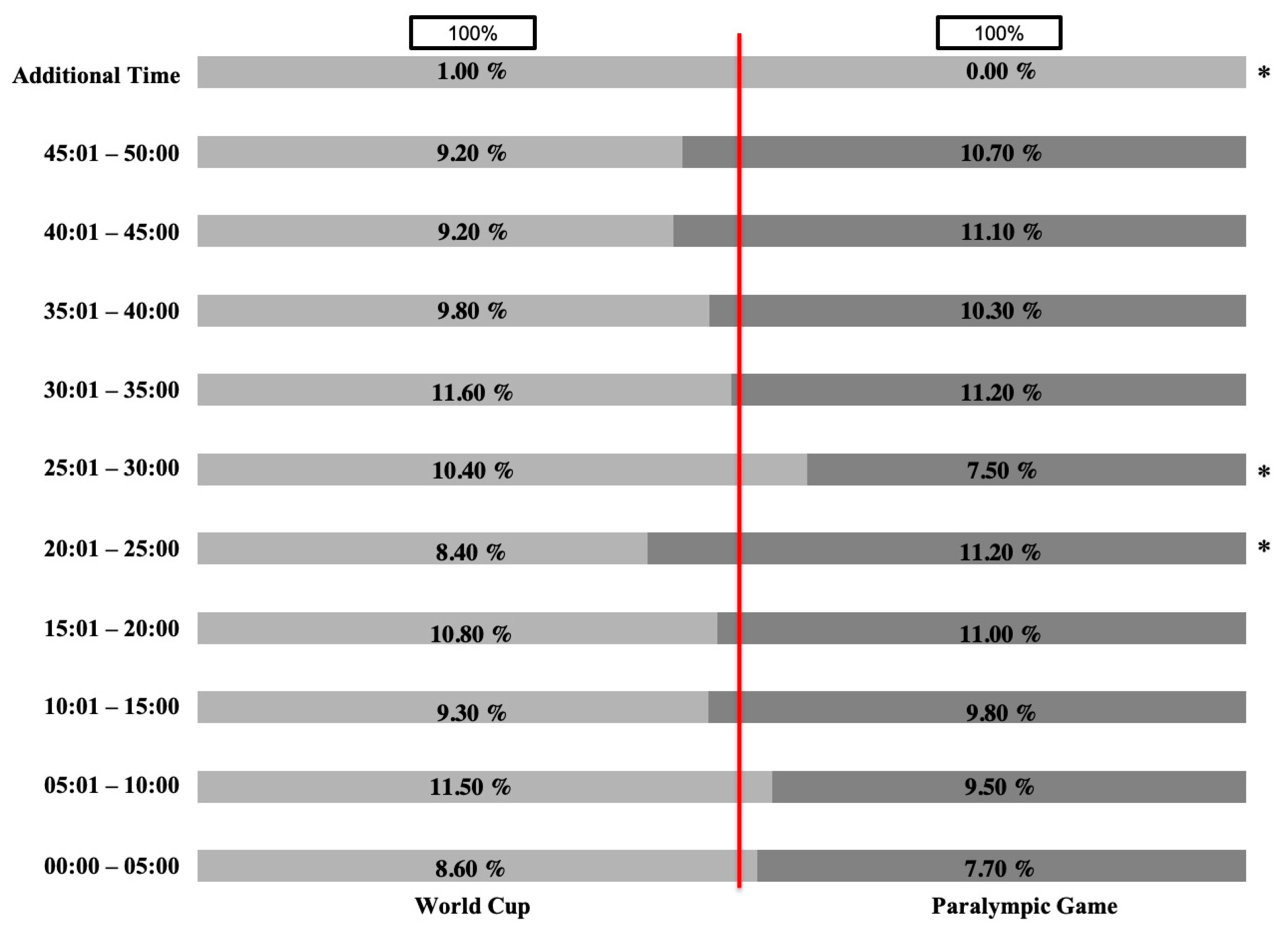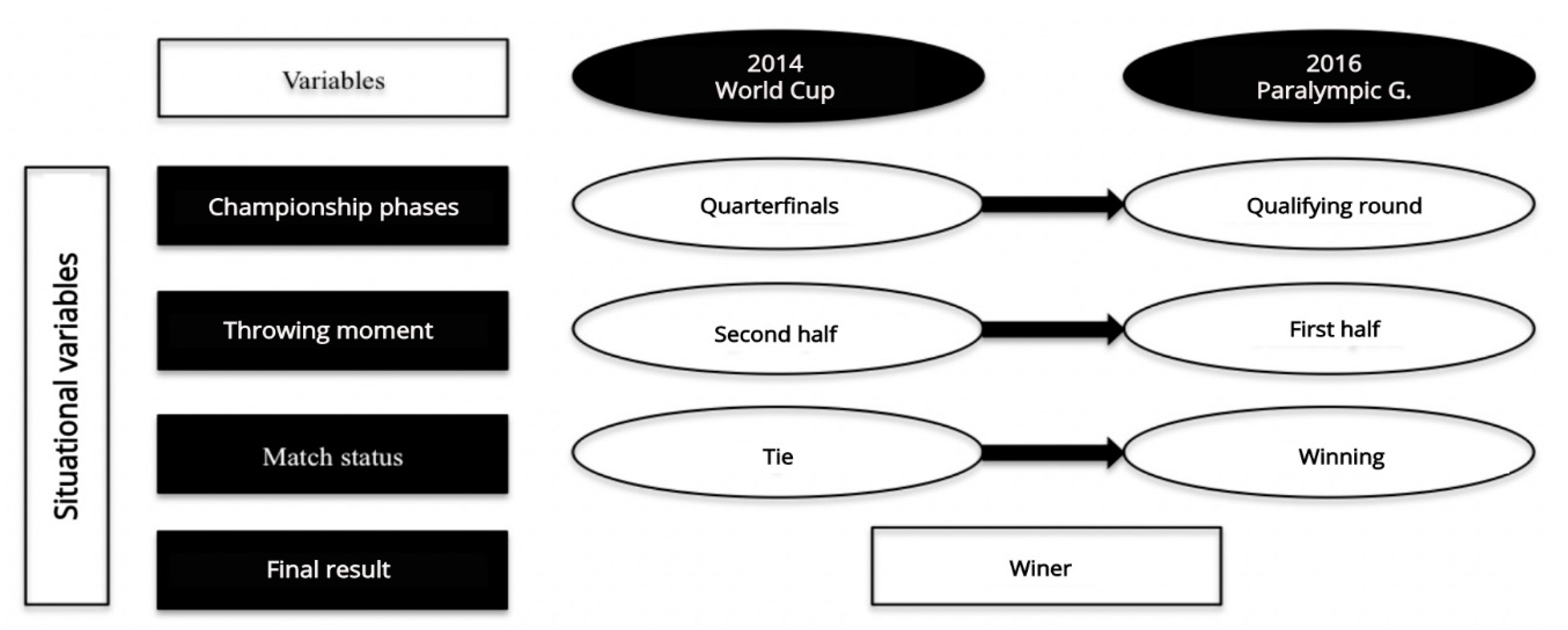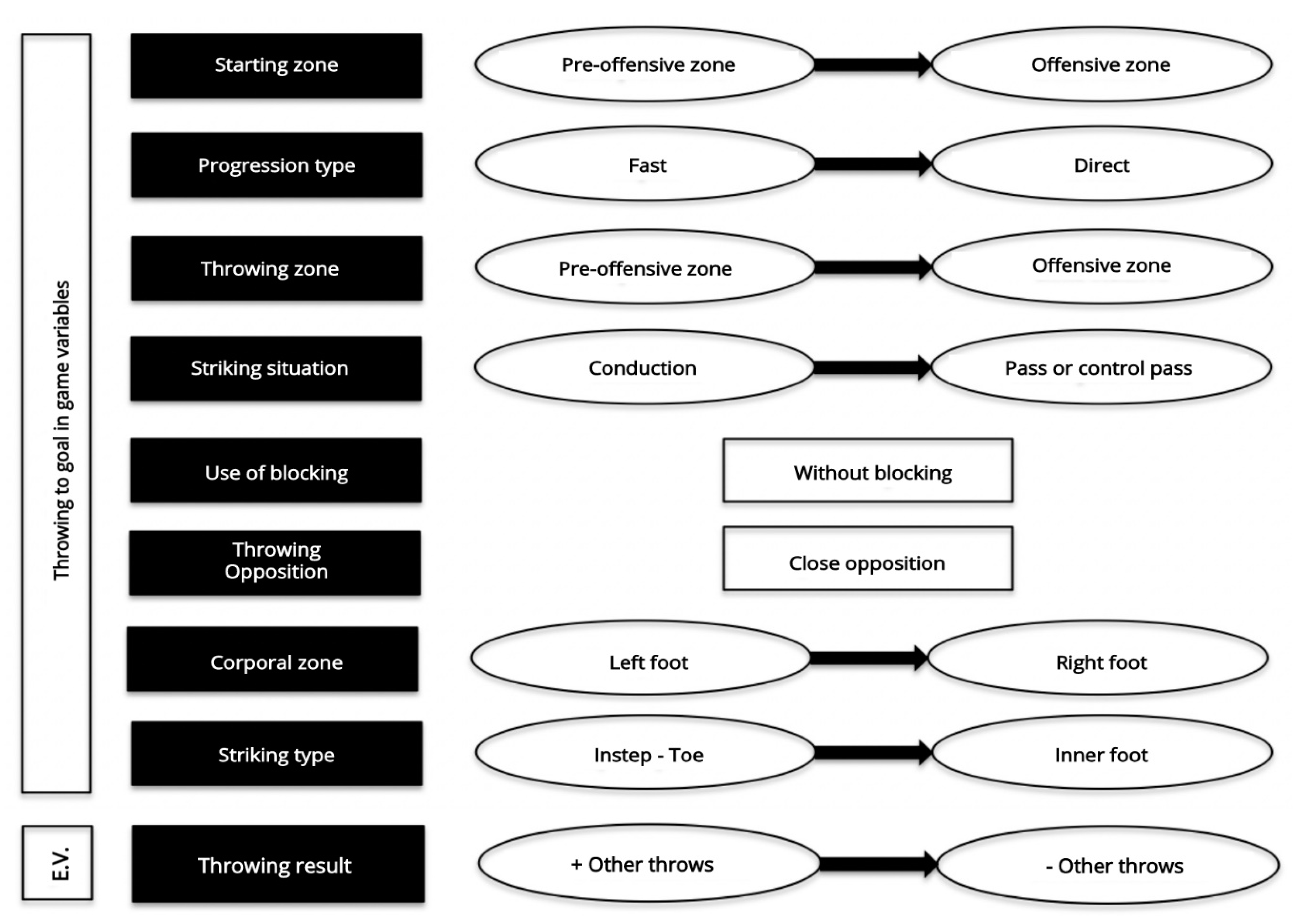Differences between Championships of Football 5-a-Side for Blind People
Abstract
:1. Introduction
2. Materials and Methods
2.1. Design
2.2. Sample
2.3. Variables
2.4. Procedure
2.5. Statistical Analysis
3. Results
3.1. Situational Variables
3.2. Goal throwing Variables
3.3. Efficiency Variable
4. Discussion
5. Conclusions
Author Contributions
Funding
Institutional Review Board Statement
Informed Consent Statement
Data Availability Statement
Acknowledgments
Conflicts of Interest
References
- Gorla, J.I.; De Athayde, A.; De Campos, L.; Dos Santos, C.F.; de Almeida, J.J.; Duarte, E.; Queiroga, M.R. Body composition and somatotype of athletes of Brazilian 5-a-side football team. Rev. Bras. Ciên. Esporte 2017, 39, 79–84. [Google Scholar] [CrossRef]
- Gamonales, J.M.; Muñoz-Jiménez, J.; León, K.; Ibáñez, S.J. Football 5-a-side for individuals with visual impairments: A review of the literature. Eur. J. Adapt. Phys. Act. 2018, 11, 1–19. [Google Scholar] [CrossRef] [Green Version]
- Gamonales, J.M.; León, K.; Muñoz-Jiménez, J.; González-Espinosa, S.; Ibáñez, S.J. Validation of the IOLF5C instrument for the efficacy of shooting on goal in football for the blind. Rev. Int. Med. Cien. Deporte 2018, 18, 359–379. [Google Scholar] [CrossRef]
- Gamonales, J.M.; Muñoz-Jiménez, J.; León, K.; Ibáñez, S.J. Reliability and inter-coders training in the analysis of football for blind persons. RETOS Nuevas Tend. Educ. Fís. Deporte Recreac. 2018, 34, 155–161. [Google Scholar]
- Gamonales, J.M.; Muñoz-Jiménez, J.; León, K.; Ibáñez, S.J. Efficacy oh shots on goal in football for the visually impaired. Int. J. Perform. Anal. Sport 2018, 18, 393–409. [Google Scholar] [CrossRef]
- Gamonales, J.M.; León, K.; Rojas-Valverde, D.; Sánchez-Ureña, B.; Muñoz-Jiménez, J. Data mining to select relevant variables influencing external and internal workload of elite blind 5-a-side soccer. Int. J. Environ. Res. Public Health 2021, 18, 3155. [Google Scholar] [CrossRef] [PubMed]
- Gamonales, J.M.; Muñoz-Jiménez, J.; Mancha-Triguero, D.; Ibáñez, S.J. The influence of the competition phase and the result of the match on the competitive demands in football 5-a-side for the visually impaired. Int. J. Perform. Anal. Sport 2020, 1–11. [Google Scholar] [CrossRef]
- Robles, F.J.; Castellano, J.; Perea, A. Differences of the game between the football Spanish team and its rivals. Rev. Iberoam. Cien. Act. Fís. Deporte 2014, 3, 1–8. [Google Scholar]
- Hughes, M.; Franks, I. Analysis of passing sequences, shots and goals in soccer. J. Sports Sci. 2005, 23, 509–514. [Google Scholar] [CrossRef]
- Castellano, J.; Hernández-Mendo, A.; Morales, V.; Anguera, M.T. Optimising a probabilistic model of the development of play in soccer. Qual. Quant. 2007, 41, 93–104. [Google Scholar] [CrossRef] [Green Version]
- Scoulding, A.; James, N.; Taylor, J. Passing in the soccer World Cup 2002. Int. J. Perform. Anal. Sport 2004, 4, 36–41. [Google Scholar] [CrossRef]
- Xu, J.; Shen, J.; Zhou, X. Offensive and defensive characteristics of 18th FIFA World Cup. J. Sports Sci. Med. 2007, 10, 203. [Google Scholar]
- Liu, H.; Gómez-Ruano, M.A.; Lago-Peñas, C.; Sampaio, J. Match statistics related to winning in the group stage of 2014 Brazil FIFA World Cup. J. Sports Sci. 2015, 1–9. [Google Scholar] [CrossRef] [PubMed]
- Castellano, J.; Perea-Rodríguez, A.; Hernández-Mendo, A. Análisis de la evolución del fútbol a lo largo de los mundiales. Psicothema 2008, 20, 928–932. [Google Scholar]
- Wallace, J.L.; Norton, K.I. Evolution of World Cup soccer final games 1966-2010: Game structure, speed and play patterns. J. Sci. Med. Sport 2014, 17, 223–228. [Google Scholar] [CrossRef] [PubMed]
- Konstadinidou, X.; Tsigilis, N. Offensive playing profiles of football teams from the 1999 Women’s World Cup Finals. Int. J. Perform. Anal. Sport 2005, 5, 61–71. [Google Scholar] [CrossRef]
- Valez, A.; Areces, A.; Blanco, H.; Arce, C. Design and application of a multidimensional battery of performance indicators for evaluating competitive performance in top-level football. Int. J. Sport Sci. 2011, 7, 103–112. [Google Scholar]
- Barreira, D.; Garganta, J.; Castellano, J.; Prudente, J.; Anguera, M.T. Evolution of attacking Patterns in elite-level soccer between 1982 and 2010: The application of lag sequential analysis. Rev. Psicol. Deporte 2014, 23, 139–146. [Google Scholar]
- García-Rubio, J.; Gómez-Ruano, M.A.; Lago-Peñas, C.; Ibáñez, S.J. Effect of match venue, scoring first and quality of opposition on match outcome in the UEFA Champions League. Int. J. Perform. Anal. Sport 2015, 15, 527–539. [Google Scholar] [CrossRef]
- Caballero, P.; García-Rubio, J.; Ibáñez, S.J. Influence of situational variables on the U´18 soccer performance analysis. RETOS Nuevas Tend. Educ. Fís. Deporte Recreac. 2017, 32, 224–227. [Google Scholar]
- Taylor, J.; Mellalieu, S.; James, N.; Barter, P. Situation variable effects and tactical performance in professional association football. Int. J. Perform. Anal. Sport 2010, 5, 255–269. [Google Scholar] [CrossRef]
- Lago-Ballesteros, J.; Lago-Peñas, C. Performance in team Sports: Identifying the keys to success in soccer. J. Hum. Kinet. 2010, 25, 85–91. [Google Scholar] [CrossRef]
- Castellano, J.; Casamichana, D.; Lago-Peñas, C. The use of match statistics that discriminate between successfut and unsuccessfun soccer teams. J. Hum. Kinet. 2012, 31, 139–147. [Google Scholar] [CrossRef]
- Gómez-Ruano, M.A.; Gómez-López, M.T.; Jiménez-Sáiz, S.L. Differences between winning and losing teams football match type function by studying performance indicators. Rev. Euroam. Cienc. Deporte 2013, 2, 37–41. [Google Scholar] [CrossRef]
- Yiannakos, A.; Armatas, V. Evaluation of de goal scoring Patterns in European Championship in Portugal 2004. Int. J. Perform. Anal. Sport 2006, 121, 223–243. [Google Scholar] [CrossRef]
- Lago-Peñas, C.; Martín-Acero, R.; Seirul-lo, F. Team performance in soccer. Modelling the main variables of F.C. Barcelona. Apunts 2007, 90, 51–58. [Google Scholar]
- Tenga, A.; Ronglan, L.T.; Bahr, R. Measuring the effectiveness of offensive match-play professional soccer. Eur. J. Sport Sci. 2010, 10, 269–277. [Google Scholar] [CrossRef]
- Garganta, J. Análisis del juego en el fútbol. El recorrido evolutivo de las concepciones, métodos e instrumentos. Rev. Entrenamiento Deportivo 2000, 14, 6–13. [Google Scholar]
- Gómez-Ruano, M.A. The importance of performance analysis as an emergent research topic in sport sciences. RICYDE Rev. Int. Cienc. Deporte 2017, 13, 1–4. [Google Scholar] [CrossRef]
- Reina-Gómez, A.; Hernández-Mendo, A. Football performance indicators review. Rev. Iberoam. Cienc. Act. Fís. Deporte 2012, 1, 1–14. [Google Scholar] [CrossRef] [Green Version]
- Ibáñez, S.J.; Feu, S.; García, J.; Parejo, I.; Cañadas, M. Shot differences between professional (ACB) and amateur (EBA) basketball teams. Multifactorial study. Rev. Psicol. Deporte 2009, 18, 313–317. [Google Scholar]
- O’Donoghue, P. An Introduction to Performance Analysis of Sport; Routledge Taylor & Francis Group: London, UK; New York, NY, USA, 2015. [Google Scholar]
- Ardá, T.; Maneiro, R.; Rial, A.; Losada, J.L.; Casal, C.A. Efficiency analysis of corner kicks in the 2010 World Cup. Trying to identify the explanatory variables. Rev. Psicol. Deporte 2014, 1, 165–172. [Google Scholar]
- Lames, M.; Mcgarry, T. On the search for reliable performance indicators in game sports. Int. J. Perform. Anal. Sport 2007, 7, 62–79. [Google Scholar] [CrossRef]
- Montero, I.; León, O.G. A guide for naming research studies in Psychology. Int. J. Clin. Health Psychol. 2007, 7, 847–862. [Google Scholar]
- Gamonales, J.M.; Muñoz-Jiménez, J.; León, K.; Ibáñez, S.J. Effectiveness of the Launch at FA5 for Blind Persons in 2016 Paralympic Games. Rev. Int. Med. Cienc. Act. Fís. Deporte 2019, 19, 745–764. [Google Scholar] [CrossRef]
- Crewson, P. Applied Statistics Handbook; AcaStat Software: Leesburg, VA, USA, 2006. [Google Scholar]
- Newell, J.; Aitchison, T.; Grant, S. Statistics for Sports and Exercise Science: A Practical Approach; Routledge: London, UK, 2014. [Google Scholar]
- Field, A. Discovering Statistics Using SPSS, 3rd ed.; Sage Publications Ltd: London, UK, 2009. [Google Scholar]
- Ciampolini, V.; Ibáñez, S.J.; Nunes, E.; Borgatto, A.; Nascimento, J. Factors associated with basketball field goals made in the 2014 NBA finals. Motriz 2017, 23, 1–7. [Google Scholar] [CrossRef] [Green Version]
- García-Rubio, J.; Ibáñez, S.J.; Gómez-Ruano, M.; Sampaio, J. Basketball Game-related statistics discriminating ACB league teams according to game location, game outcome and final score differences. Int. J. Perform. Anal. Sport 2014, 14, 443–452. [Google Scholar] [CrossRef]
- Ortega, E.; Villarejo, D.; Palao, J.M. Differences in game statistics between winning and losing rugby teams in the six nations tournament. J. Sports Sci. Med. 2009, 8, 523–527. [Google Scholar] [PubMed]
- Koch, C.; Tilp, M. Beach volleyball techniques and tactics: A comparison of male and female playing characteristics. Kinesiology 2009, 41, 52–59. [Google Scholar]
- Ibáñez, S.J.; Sampaio, J.; Sáenz-López, P.; Giménez, J.; Janeira, M.A. Game statistics discriminating the final outcome of junior World Basketball Championship Matches (Portugal 1999). J. Hum. Mov. Stud. 2003, 45, 1–19. [Google Scholar]
- Castellano, J. Relationship between performance indicators and the success in professional football. Rev. Psicol. Ejerc. Deporte 2018, 13, 41–49. [Google Scholar]
- Lapresa, D.; Álvarez, L.; Arana, J.; Garzón, B.; Caballero, V. Observational analysis of the offensive sequences that ended in a shot by the winning team of the 2010 UEFA Futsal Championship. J. Sports Sci. 2013, 31, 1731–1739. [Google Scholar] [CrossRef] [PubMed]
- Almeida, C.; Volossovitch, A.; Duarte, R. Penalty kick outcomes in UEFA club competitions (2010–2015): The roles of situational, individual and performance factors. J. Perform. Anal. Sport 2017, 16, 508–522. [Google Scholar] [CrossRef]
- Giagazoglou, P.; Katis, A.; Kellis, E.; Natsikas, C. Differences in soccer kick kinematics between blind players and controls. Adapt. Phys. Act. Q. 2011, 28, 251–266. [Google Scholar] [CrossRef] [PubMed]




| Type of Variables | Categorical Core | |
|---|---|---|
| Independent | Competition Type | Championship |
| Dependents | Situational variables | Championship phases |
| Throwing moment | ||
| Match status | ||
| Final result | ||
| Variables of goal throwing in game | Starting zone | |
| Progression type | ||
| Throwing zone | ||
| Striking situation | ||
| Use of blocking | ||
| Throwing opposition | ||
| Corporal zone | ||
| Striking type | ||
| Efficiency variable | Throwing result | |
| Competition Type | |||||||
|---|---|---|---|---|---|---|---|
| Variables | χ2 | gl. | Sig. | φc | Sig. | Association Level | |
| Championship phases | 173.344 | 5 | 0.000 | * | 0.279 | 0.000 | Low |
| Throwing moment | 19.155 | 10 | 0.038 | * | 0.093 | 0.038 | Small |
| Match status | 8.472 | 2 | 0.014 | * | 0.062 | 0.014 | Small |
| Final result | 5.833 | 2 | 0.054 | 0.051 | 0.054 | --- | |
| Starting zone | 15.683 | 3 | 0.001 | * | 0.084 | 0.001 | Small |
| Progression type | 97.169 | 2 | 0.000 | * | 0.209 | 0.000 | Low |
| Throwing zone | 127.285 | 3 | 0.000 | * | 0.239 | 0.000 | Low |
| Striking situation | 51.006 | 3 | 0.000 | * | 0.151 | 0.000 | Low |
| Use of blocking | 6.688 | 4 | 0.151 | 0.054 | 0.153 | --- | |
| Throwing opposition | 4.367 | 4 | 0.359 | 0.044 | 0.359 | --- | |
| Corporal zone | 28.077 | 2 | 0.000 | * | 0.112 | 0.000 | Low |
| Striking type | 33.984 | 4 | 0.000 | * | 0.124 | 0.000 | Low |
| Throwing result | 11.169 | 4 | 0.025 | * | 0.071 | 0.025 | Small |
| Variable | Competition Type | ||||||
|---|---|---|---|---|---|---|---|
| 2014 World Cup | 2016 Paralympic Games | ||||||
| n | % | ASR | n | % | ASR | ||
| Match status | Winner | 266 | 17.8 | −2.9 | 167 | 22.9 | 2.9 |
| Loser | 227 | 15.2 | 0.1 | 110 | 15.1 | −0.1 | |
| Tie | 1004 | 67.1 | 2.3 | 453 | 62.1 | −2.3 | |
| Variables | Competition Type | ||||||
|---|---|---|---|---|---|---|---|
| 2014 World Cup | 2016 Paralympic Games | ||||||
| n | % | ASR | n | % | ASR | ||
| Starting zone | Defensive zone | 420 | 28.1 | −1.8 | 232 | 31.8 | 1.8 |
| Pre-defensive zone | 303 | 20.2 | 1.1 | 134 | 18.4 | −1.1 | |
| Pre-offensive zone | 375 | 25.1 | 3.4 * | 136 | 18.6 | −3.4 * | |
| Offensive zone | 399 | 26.7 | −2.3 * | 228 | 31.2 | 2.3 * | |
| Progression type | Combinatorial | 159 | 10.6 | −2.5 * | 104 | 14.2 | 2.5 * |
| Direct | 318 | 21.1 | −8.7 * | 283 | 38.8 | 8.7 * | |
| Fast | 1020 | 68.1 | 9.6 * | 343 | 47.0 | −9.6 * | |
| Throwing zone | Defensive zone | 37 | 2.5 | 0.6 | 15 | 2.1 | −0.6 |
| Pre-defensive zone | 36 | 2.4 | −0.3 | 19 | 2.6 | 0.3 | |
| Pre-offensive zone | 392 | 26.2 | 11.2 * | 45 | 6.2 | −11.2 * | |
| Offensive zone | 1032 | 68.9 | −10.4 * | 651 | 89.2 | 10.4 * | |
| Striking situation | Pass-control-throwing | 74 | 4.9 | −2.6 * | 56 | 7.7 | 2.6 * |
| Pass-throwing | 50 | 3.3 | −5.5 * | 64 | 8.8 | 5.5 * | |
| Conduction-throwing | 1275 | 85.2 | 6.7 * | 536 | 73.4 | −6.7 * | |
| Others | 98 | 6.5 | −3.0 * | 74 | 10.1 | 3.0 * | |
| Corporal zone | Right foot | 1117 | 74.6 | −5.3 * | 617 | 84.5 | 5.3 * |
| Left foot | 316 | 21.1 | 4.9 * | 92 | 12.6 | −4.9 * | |
| Others | 64 | 4.3 | 1.6 | 21 | 2.9 | −1.6 | |
| Striking type | Inner foot | 336 | 23.1 | −4.6 * | 236 | 32.3 | 4.6 * |
| Instep-toe | 987 | 65.9 | 2.4 * | 439 | 60.6 | −2.4 * | |
| Outer foot | 29 | 1.9 | 2.8 * | 3 | 0.4 | −2.8 * | |
| Heel | 1 | 0.1 | −1.8 | 3 | 0.4 | 1.8 | |
| Others | 134 | 9.0 | 2.3 * | 45 | 6.2 | −2.3 * | |
| Variable | Competition Type | |||||
|---|---|---|---|---|---|---|
| 2014 World Cup | 2016 Paralympic Games | |||||
| Throwing result | n | % | ASR | n | % | ASR |
| Success. Goal | 32 | 2.1 | −1.1 | 21 | 2.9 | 1.1 |
| Success. Throwing, no goal with rebound | 334 | 22.3 | 1.4 | 147 | 20.1 | −1.4 |
| Failure. Throwing, no goal and no rebound | 560 | 37.4 | −0.8 | 286 | 39.2 | 0.8 |
| Failure. Outside direct | 529 | 35.3 | −0.9 | 269 | 36.8 | 0.9 |
| Other throws | 42 | 2.8 | 2.8 | 7 | 1.0 | −2.8 |
Publisher’s Note: MDPI stays neutral with regard to jurisdictional claims in published maps and institutional affiliations. |
© 2021 by the authors. Licensee MDPI, Basel, Switzerland. This article is an open access article distributed under the terms and conditions of the Creative Commons Attribution (CC BY) license (https://creativecommons.org/licenses/by/4.0/).
Share and Cite
Gamonales, J.M.; Muñoz-Jiménez, J.; León, K.; Ibáñez, S.J. Differences between Championships of Football 5-a-Side for Blind People. Appl. Sci. 2021, 11, 8933. https://doi.org/10.3390/app11198933
Gamonales JM, Muñoz-Jiménez J, León K, Ibáñez SJ. Differences between Championships of Football 5-a-Side for Blind People. Applied Sciences. 2021; 11(19):8933. https://doi.org/10.3390/app11198933
Chicago/Turabian StyleGamonales, José M., Jesús Muñoz-Jiménez, Kiko León, and Sergio J. Ibáñez. 2021. "Differences between Championships of Football 5-a-Side for Blind People" Applied Sciences 11, no. 19: 8933. https://doi.org/10.3390/app11198933
APA StyleGamonales, J. M., Muñoz-Jiménez, J., León, K., & Ibáñez, S. J. (2021). Differences between Championships of Football 5-a-Side for Blind People. Applied Sciences, 11(19), 8933. https://doi.org/10.3390/app11198933








